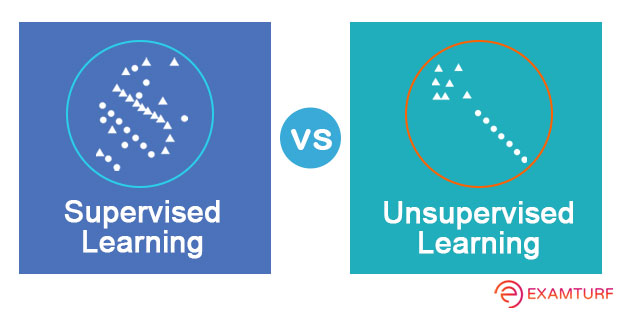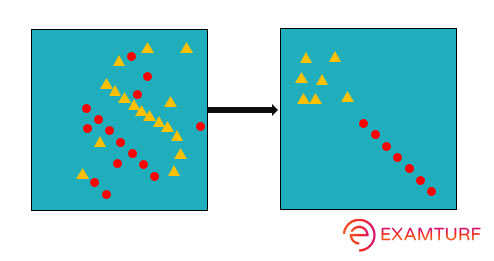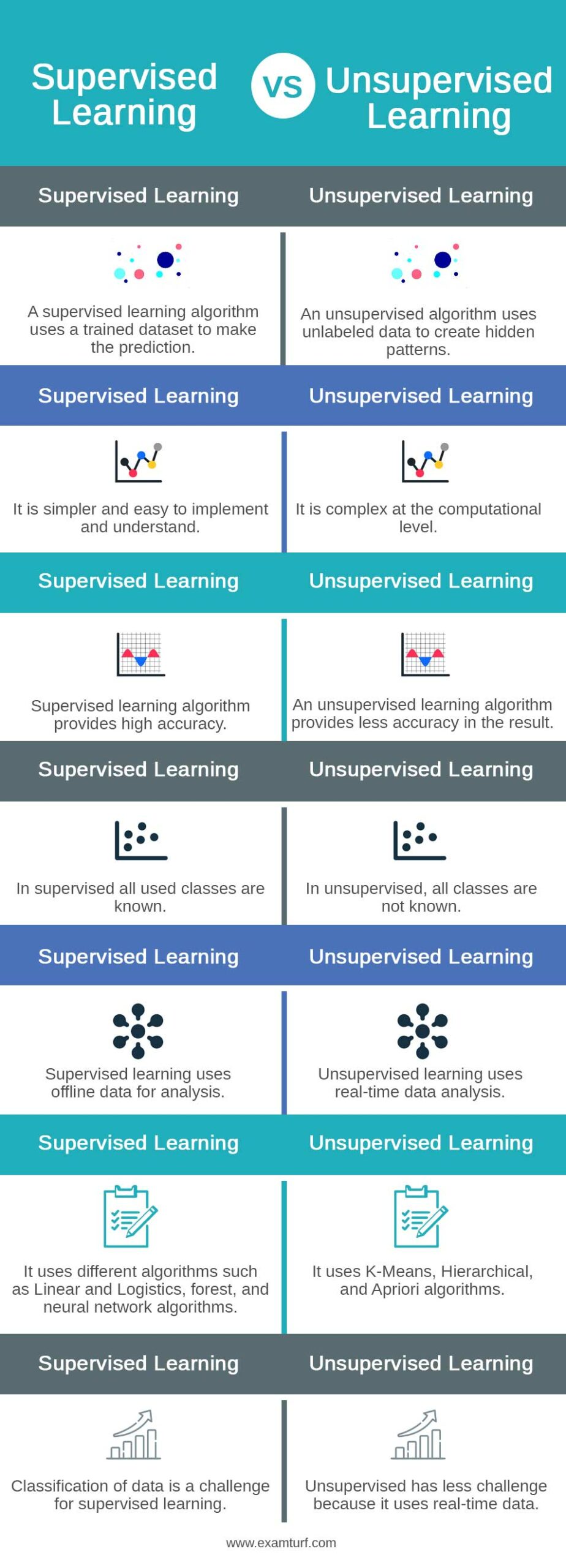
Definition of Supervised vs Unsupervised Learning
We know that both are machine learning algorithms used to classify the data, or we can say that it is used to sort out the datasets. Basically, supervised learning requires the labeled dataset, which means datasets are designed with the help of a supervised algorithm or train dataset used to make the prediction. On the other hand, unsupervised learning uses unlabeled or cluster-based datasets, and it is basically used to determine the hidden patterns of datasets.
Table of contents
- Definition of Supervised vs Unsupervised Learning
Difference Between Supervised vs Unsupervised Learning
The use of labeled datasets is the main difference between these two algorithms. In simple words, we can say that an unsupervised learning algorithm doesn’t require labeled datasets, but a supervised learning algorithm must require labeled datasets to process.
The algorithm “learns” from the training dataset in supervised learning by iteratively predicting the data and helping to find the correct answer. While managed learning models will quite often be more exact than solo learning models, they require forthright human intercession to suitably name the information. A supervised learning model, for instance, can predict the length of your commute based on the time of day, weather, and other factors. Keep in mind that validation of output variables still requires some human intervention. For instance, an unaided learning model can distinguish that internet-based customers frequently buy gatherings of items simultaneously. Nonetheless, an information expert would have to approve that it’s a good idea for a suggestion motor to bunch child garments with a request for diapers, fruit purée, and sippy cups.
What is Supervised Learning?
As the name suggests, a supervised learning supervisor is a supervisor as a trainer. Basically, we use well-labeled data to teach or train the machine in supervised learning. This indicates that the correct answer has already been assigned to some data. After that, a new set of examples (data) is given to the machine so that the supervised learning algorithm can correctly produce an outcome from labeled data by analyzing the training data (set of training examples). Let’s consider how we can find the mapping function as follows.
A = f(B)
Where,
- A – Used for the input
- B – Used for the output
The working architecture of supervised learning can be seen in the below screenshot.

Basically, the supervised algorithm is used for two types of issues: Classification and Regression.
Classification: Classification is nothing but the output category, such as black and white.
Regression: Regression means when we have real value that changes on real-time entities such as dollars or weight.
What is Unsupervised Learning?
Another type of machine learning is unsupervised learning, in which patterns are different from unlabeled input data. Unsupervised learning aims to discover patterns and structures in input data. No supervision is required for unsupervised learning. Instead, it independently discovered patterns in the data. It is used for Clustering and Association.
Clustering: Clustering means a grouping of data where we have different behavior of data, as shown in the below screenshot.

Association: Association means we have rules that we want to implement means which give detailed information about the data.
Head to Head Comparison Between Supervised vs Unsupervised Learning (Infographics)
Below are the top 7 differences between Supervised and Unsupervised Learning:

Key Differences between Supervised vs Unsupervised Learning
Let us look at the key differences between Supervised and Unsupervised Learning:
Supervised machine learning uses the labeled dataset to train the model. Basically supervised learning has been working on two major problems such as regression and classification. Here entered data contains the output so it gives a better result. Supervised learning provides more accurate results because we know that it contains the trained data set. The implementation of supervised learning is a little bit complex. The best example of supervised learning is Spam detection, handwriting detection, and speech recognition.
In supervised learning, the algorithm uses the old dataset for prediction, whereas unsupervised uses real-time data and tries to find out all the hidden patterns of data. An unsupervised learning algorithm doesn’t require labeled datasets. In unsupervised, we can only use input data to make predictions, and it has less accuracy as compared to supervised, which means it uses real-time data to make predictions. Some application names are data preprocessing and detection of fraudulent transactions etc.
Supervised Learning Requirement
Now let’s see the requirements for supervised learning as follows.
| Component | Minimum Requirement |
| CPU | X16- Core Processor/AMD Ryzen |
| Graphic | NVIDIA |
| RAM | 64 GB |
| OS | Windows 10/Ubuntu |
| Programming Language | Python 3.6 |
| Library | Tensorflow 1.11 |
| Algorithm | Linear and Logistics, Forest, and neural network |
Unsupervised Learning Requirement
Now let’s see the requirement for unsupervised learning as follows.
| Component | Minimum Requirement |
| CPU | X16- Core Processor/AMD Ryzen |
| Graphic | NVIDIA |
| RAM | 64 GB |
| OS | Windows 10/Ubuntu |
| Programming Language | Python 3.6 |
| Library | Tensorflow 1.11 |
| Algorithm | Linear and Logistics, Forest, and neural network |
Comparison Table of Supervised vs Unsupervised Learning
The table below summarizes the comparisons between Supervised vs Unsupervised Learning:
| Supervised Learning | Unsupervised Learning |
| A supervised learning algorithm uses a trained dataset to make the prediction. | An unsupervised algorithm uses unlabeled data to create hidden patterns. |
| It is simpler and easy to implement and understand. | It is complex at the computational level. |
| Supervised learning algorithm provides high accuracy. | An unsupervised learning algorithm provides less accuracy in the result. |
| In supervised, all used classes are known. | In unsupervised, all classes are not known. |
| Supervised learning uses offline data for analysis. | Unsupervised learning uses real-time data analysis. |
| It uses different algorithms such as Linear and Logistics, forest, and neural network algorithms. | It uses K-Means, Hierarchical, and Apriori algorithms. |
| Classification of data is a challenge for supervised learning. | Unsupervised has less challenge because it uses real-time data. |
Purpose of Supervised Learning
- A supervised learning algorithm allows us to create or make the prediction of data with the help of an old dataset.
- By using supervised, we can optimize the performance as well increase the accuracy of results.
- By using a supervised learning algorithm, we can easily solve all types of real word problems.
Purpose of Unsupervised Learning
- It helps us to find out all the hidden patterns of datasets.
- By using unsupervised learning, we can easily categorize the dataset, and it helps us to make the features.
- It uses all real-time data, so data can be analyzed.
- We can easily extract the unlabeled data from the machine, but we need to do manual work.
Conclusion
From this article, we are able to understand supervised and unsupervised learning. It provides the basic idea and implementation of supervised and unsupervised learning, and we also see the representation of supervised and unsupervised learning. In the end, we got an idea about the uses of supervised and unsupervised learning.
Recommended Articles
This is a guide to Supervised vs Unsupervised Learning. Here we discuss Supervised vs Unsupervised Learning key differences with infographics and a comparison table in detail. You can also go through our other suggested articles to learn more –
- Data Science vs. Machine Learning
- Big Data vs. Machine Learning
- Predictive vs. Prescriptive Analytics
- Data Science vs. Data Engineering
Are you preparing for the entrance exam ?
Join our Data Science test series to get more practice in your preparation
View More